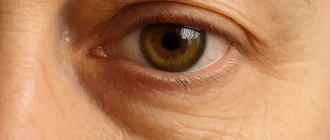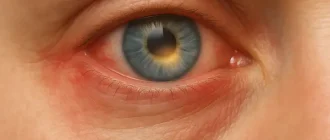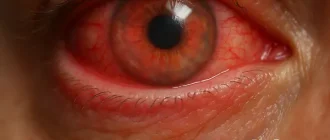What is High Eye Pressure, and Should You Be Concerned? High eye pressure, also known as ocular hypertension, is a condition where the pressure inside the eye, known as intraocular pressure (IOP), is higher than normal. But does it necessarily mean you have glaucoma or that your vision is at risk? Not quite. Ocular hypertension is not a disease by itself, but it is a major risk factor for glaucoma, which is one of the leading causes of vision loss worldwide. Let’s dive deeper into what ocular hypertension means, how it can affect your health, and what you can do about it.
What Causes High Eye Pressure?
To understand ocular hypertension, it helps to first understand what regulates eye pressure. The eye contains a fluid called aqueous humor, which maintains eye shape and nourishes the surrounding tissues. When there is an imbalance in the production and drainage of this fluid, it leads to elevated eye pressure.
But what causes this imbalance? There are several factors, including:
- Increased Production of Aqueous Humor: If your eye produces too much of this fluid, it builds up and increases pressure.
- Reduced Drainage: If the drainage channels in your eye are blocked or functioning inefficiently, the fluid cannot escape, raising the intraocular pressure.
- Certain Medications: Corticosteroids, used for treating asthma or other inflammatory conditions, can sometimes lead to increased eye pressure.
- Genetics: Ocular hypertension tends to run in families, meaning if your parents or grandparents had it, you might be at higher risk.
Did you know?
Approximately 10% of people over the age of 40 experience elevated eye pressure, and among them, about 1 in 10 might develop glaucoma if left untreated (source).
Risk of Developing Glaucoma Based on Eye Pressure Levels
| Eye Pressure Level (mm Hg) | Risk of Developing Glaucoma (%) |
|---|---|
| 10-15 mm Hg (Low) | 10% |
| 16-21 mm Hg (Moderate) | 30% |
| 22-25 mm Hg (High) | 60% |
| Above 25 mm Hg (Very High) | 90% |
This histogram compares the risk of developing glaucoma based on different levels of intraocular pressure (IOP). Higher eye pressure significantly increases the risk, underscoring the importance of early detection and management.
How Do You Know if You Have High Eye Pressure?
Is there a way to feel ocular hypertension? Unlike conditions like migraines or high blood pressure, ocular hypertension is generally asymptomatic. Most people with high eye pressure feel no discomfort or noticeable difference in their vision. This is why regular eye exams are critical, especially as you age.
The only way to determine if you have high eye pressure is through an eye exam. During an eye exam, your optometrist or ophthalmologist will use a tool called a tonometer to measure your intraocular pressure. Normal eye pressure is typically between 10-21 mm Hg. If your pressure exceeds 21 mm Hg, you might be diagnosed with ocular hypertension.
Table: Average Intraocular Pressure (IOP) by Age Group
| Age Group | Average IOP (mm Hg) |
|---|---|
| Under 30 years | 15.5 |
| 30-40 years | 16.3 |
| 40-50 years | 17.2 |
| Over 50 years | 18.1 |
This table demonstrates that as we age, average eye pressure can increase slightly. Regular monitoring is crucial to detect changes over time.
What Are the Risks of Leaving High Eye Pressure Untreated?
You might wonder, if ocular hypertension doesn’t cause symptoms, why worry about it? The problem is that if untreated, high eye pressure can damage the optic nerve, the crucial structure that transmits visual information from your eye to your brain. Damage to the optic nerve can lead to glaucoma, which, if untreated, results in irreversible vision loss.
According to the American Academy of Ophthalmology, people with ocular hypertension have a 10-15% chance of developing glaucoma over five years without treatment. Therefore, identifying and treating ocular hypertension early can significantly reduce your risk of permanent vision loss.
Treatment Options for High Eye Pressure
How can you treat high eye pressure if it’s asymptomatic? Treatment typically aims to reduce eye pressure to a normal range to prevent optic nerve damage. Options include:
- Eye Drops: The first-line treatment for ocular hypertension involves prescription eye drops that reduce the production of aqueous humor or increase the fluid outflow.
- Laser Therapy: For individuals who do not respond well to drops, laser trabeculoplasty is sometimes recommended to help improve the drainage of fluid from the eye.
- Surgery: In more severe cases, surgical options can be considered to create a new drainage pathway for the fluid.
Did you know?
Studies show that about 75% of patients treated with eye drops see a reduction in eye pressure by at least 20%, decreasing their risk of glaucoma significantly (source).
Effectiveness of Treatments for Ocular Hypertension
| Treatment Type | Reduction in Eye Pressure (%) |
|---|---|
| No Treatment | 0% |
| Eye Drops | 75% |
| Laser Therapy | 60% |
| Surgery | 85% |
This histogram compares the effectiveness of different treatments for reducing intraocular pressure (IOP) in individuals with ocular hypertension. It highlights the importance of selecting an appropriate treatment to prevent the development of glaucoma.
Lifestyle Considerations for Managing Eye Pressure
Are there any natural ways to lower eye pressure? Yes, there are. Lifestyle changes can support healthy eye pressure management:
- Regular Exercise: Moderate, regular exercise such as walking or swimming can reduce eye pressure. However, avoid intense activities like heavy weightlifting, which can temporarily increase eye pressure.
- Diet Rich in Antioxidants: Eating leafy greens, carrots, and other antioxidant-rich foods can support eye health. Some studies suggest that omega-3 fatty acids, found in fish, may also have protective benefits.
- Stay Hydrated, but Avoid Excessive Water Intake at Once: Drinking too much water in a short period can temporarily increase intraocular pressure.
Our Editorial Team’s Advice
High eye pressure or ocular hypertension is a silent condition that can be easily overlooked but poses significant risks if left unchecked. Regular eye exams are your best defense, especially as you age. If you are diagnosed with high eye pressure, follow your doctor’s treatment recommendations, and consider lifestyle changes that promote eye health. Prevention today can save your vision tomorrow.





